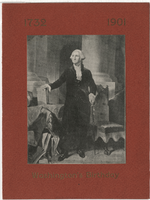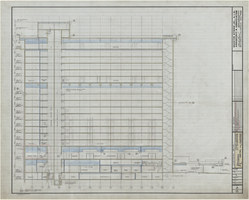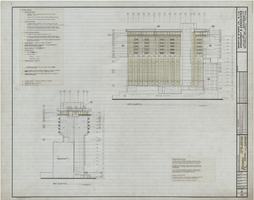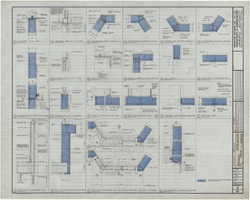Search the Special Collections and Archives Portal
Search Results
Andy Hafen oral history interview
Identifier
Abstract
Oral history interview with Andy Hafen conducted by Stefani Evans and Claytee D. White on August 22, 2016 for the Building Las Vegas Oral History Project. In this interview, Hafen discusses his upbringing in Henderson, Nevada. He recalls being elected to the City Council in 1987, the expansion of Henderson, and the development of the Water Street District. Hafen then talks about redevelopment of historic areas and the increase in businesses in Henderson. Later, Hafen discusses Lake Las Vegas, the drought and its effect on Lake Mead, and the challenges in developing Lake Las Vegas. Lastly, Hafen explains the how Nevada State College (NSC) has become the necessary link between the College of Southern Nevada (CSN) and the University of Nevada, Las Vegas (UNLV).
Archival Collection
Louis Conner oral history interview
Identifier
Abstract
Oral history interview with Louis Conner conducted by John Grygo on March 22, 2013 for the African Americans in Las Vegas: a Collaborative Oral History Project. In this interview, Conner discusses his personal history and growing up in Tallulah, Louisiana. He talks about moving to Las Vegas, Nevada with his family for job opportunities in the late 1950s. Conner describes his employment at the Stardust Hotel, segregation, and living in West Las Vegas. He then talks about integration in the mid-1960s, Jackson Street entertainment, and the changing demographic of the Westside. Lastly, Conner discusses the development of Las Vegas, families moving out of the Westside, and new businesses in the area.
Archival Collection

Washington's birthday at the Hotel Atlas, menu, Friday, February 22, 1901
Date
Archival Collection
Description
Text
Charlotte Ellsworth oral history interview
Identifier
Abstract
Oral history interview with Charlotte Ellsworth conducted by Jane Ellsworth Olive on March 22, 1977, December 26, 1980, December 28, 1981, and August 06, 1987 for the Ralph Roske Oral History Project on Early Las Vegas. In the span of four interviews, Ellsworth discusses her family’s history, the growth of Henderson, Nevada, working at the Basic Magnesium Plant, and life during World War II. She also talks about war bond drives, the Oakey Theaters, Nevada Chamber of Commerce, "western" clothes, and hotels like the Flamingo Hotel and the Riviera Hotel. She then describes visiting places like Canada, Salt Lake City, Utah, Washington, D. C., and San Francisco, California.
Archival Collection
Harry Mortenson oral history interviews
Identifier
Abstract
Oral history interviews with Harry Mortenson conducted by Claytee D. White on April 08, 2014, April 22, 2014, and May 06, 2014 for the Boyer Early Las Vegas Oral History Project. In the first interview, Mortenson discusses his personal background, working at Los Alamos National Laboratory in New Mexico, and arriving to Nevada to work as a nuclear physicist at the Nevada Test Site. Mortenson describes his work and recalls anecdotes from his employment. He then talks about his company, Sigma Scientific, and explains the different projects where he worked as a consultant. In the second interview, Mortenson discusses the methods of transportation used to arrive to the Nevada Test Site, his involvement with different organizations, and his tenure in the Nevada State Legislature. In the final interview, Mortenson discusses the device he built to take photographs of the nuclear reactor cores at Las Alamos National Laboratory, and explains how that device worked.
Archival Collection
Maxine Butler oral history interview
Identifier
Abstract
Oral history interview with Maxine Butler conducted by Frank Johnson on April 22, 2016 for the African Americans in Las Vegas: a Collaborative Oral History Project. In this interview, Butler discusses her early life in Jonesboro, Louisiana. She talks about moving to Las Vegas, Nevada in 1965, the Westside, and businesses on Jackson Street. Butler recalls working at The Cove as a cocktail waitress, the reopening of Moulin Rouge Hotel, and the African American community on the Westside. Later, Butler discusses her involvement at Greater Evergreen Missionary Baptist Church, the importance of church to the African American community, and compares church life in Jonesboro and Las Vegas. Lastly, Butler talks about changes in the Westside.
Archival Collection
Gerald L. Connor oral history interview
Identifier
Abstract
Oral history interview with Gerald Connor conducted by James Bonnell on February 22, 1977 for the Ralph Roske Oral History Project on Early Las Vegas. Connor first discusses moving to Las Vegas, Nevada and serving as a pilot in the United States Air Force. He then discusses his education at the University of Nevada, Las Vegas and his church membership. Topics that Connor discusses during the interview also include changes in the school district and properties located in Downtown Las Vegas and the Las Vegas Strip, his political activity within the Democratic Party, the Helldorado Parades, and the early atomic tests at the Nevada Test Site.
Archival Collection



